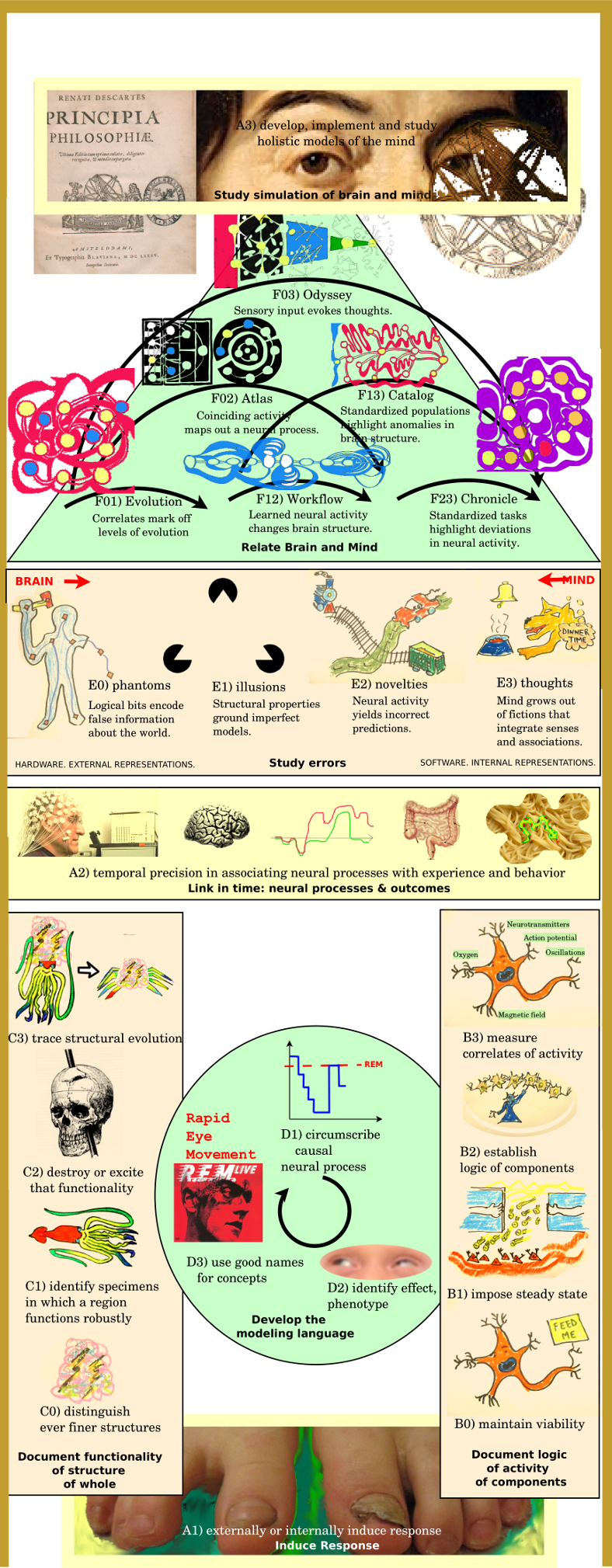- MathNotebook
- MathConcepts
- StudyMath
- Geometry
- Logic
- Bott periodicity
- CategoryTheory
- FieldWithOneElement
- MathDiscovery
- Math Connections
Epistemology
- m a t h 4 w i s d o m - g m a i l
- +370 607 27 665
- My work is in the Public Domain for all to share freely.
- 读物 书 影片 维基百科
Introduction E9F5FC
Questions FFFFC0
Software
A poster presented at the XI International Conference of Lithuanian Neuroscience Association, Behavioural Medicine and Neuroplasticity. Book of Abstracts.
Download PDF of the full poster
Expressing the Organizer of an Organism's Behavior
An Epistemological Overview of Neuroscience
Background: Neuroscience, as a discipline, makes many assumptions, as noted by Zavala, Pérez, Muñoz, and Herrera [1999-2000].
Aim: We make explicit the assumptions of neuroscience by systematizing the methods by which neuroscientists arrive at conclusions.
Materials and methods: We collect and systematize the ways that neuroscientists have figured things out as discussed in Wikipedia articles, the Brain Science Podcast, and related books.
Illustrations: We made this poster ourselves. Our poster is in the Public Domain. Created 2019.11.29. We made fair use of a few images from Wikipedia, Wikimedia Commons, Medical Xpress, Pixabay and Segorov's YouTube channel.
Findings
We collected about 150 methodological terms and concepts used in neuroscience. We succeeded in organizing them into an epistemological system of 24 ways of figuring things out, much as we did earlier for math, physics, games, and for our own philosophy, as well as for Jesus and the Gaon of Vilna.
The system consists of six structures labeled A, B, C, D, E, F.
Neuroscience starts (A1) with inducing responses (external behaviors or internal experiences) from a living organism. The key methodology (A2) is achieving temporal precision in relating neural processes with external behavior and inner experience, as by electroencephalography. Neuroscience arrives (A3) at the study of simulations of the brain and mind.
Neuroscience demands that we study the activity of components so as to (B) discover its correlates, and that we analyze the whole so as to (C) understand functionality by appreciating its evolution. We straddle these two approaches by (D) developing a social language to talk about neural processes and relate them to our mental experiences. Neuroscience teaches us to think as our brains do.
This lets us study the brain as that which organizes an organism so that it persists and proliferates within an ecosystem. We study how the brain struggles with this purpose by noting (E) four levels of errors. This leads to the notion of a thought, which is an association of disparate information, sensory and mental, that is purposeful to the organism, but otherwise nonphysical and unreal. Pavlov's dog thus has a notion of "dinner time", a nonphysical conception which flexibly gathers together the revelant sights, sounds, smells and other associations.
The mind's atoms, associative thoughts, are the brain's endless multiplicity of purposes. The mind inverts the brain, as its flip side. The "binding problem" is resolved by appreciating the reality of this duality, which permeates the epistemology of neuroscience, as foreseen by Descartes.
Six methodologies tease out the distinctions between the mind and the brain, relating logical bits, structural properties, neural activities and associative thoughts. These are six restructurings of sequences, hierarchies, and networks. We hypothesize that they can be identified with the six layers of the mammalian cortex. All mammals have minds with personal thoughts, but humans have developed languages by which they can have essentially the same thoughts.

